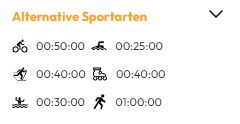In the end, the sport-specific form of training is always the most important for improving in that particular discipline. Specifically: to become a faster runner, running is the most effective form of training. However, it doesn’t mean that alternative sports should be ignored. On the contrary, they can offer several advantages.
In which situations is alternative training particularly useful?
Alternative sports can be integrated into the training programme for two different purposes. On the one hand, to provide an alternative to running training – in the true sense of the word – and thus replace a planned running session; on the other hand, to extend training (scope) without using exactly the same muscle groups as running.
The following cases fall into the first category:
- Alternative training in case of injury:
During an involuntary break from running, alternative sports can help minimise the amount of training required while keeping the body active without stressing the parts affected by the injury. - Return to running after a break:
After a break from training, you must be cautious and resume gradually. An increase from 0 to 100 is not recommended, as the musculoskeletal system must first get used to the effort again. Alternative sports can be used to spread the load over different parts of the body and still challenge the cardiovascular system. - Seasonal break to recharge energy:
Generally, at the end of a gruelling season, the body and mind are exhausted. A break from running is therefore a good way to give both body and mind time to recover. However, to avoid a complete withdrawal from physical activity, it is a good idea to turn to alternative sports (check out our other tips for resuming training after the season break).
The second category, supplementing daily training with alternative sports, includes the following points:
- Specific work on weak points:
For example, strength training is complementary to running training and is used to work on the weakest muscle groups, both to prevent injuries and to improve performance. - Increasing volume:
The amount of training for running cannot be increased at will because the physical capacity of the specific running muscles places limits on the amount of training that can be done. However, alternative sports can help increase the training volume in a more gentle way, without significantly increasing the risk of injury.
The advantages of alternative forms of training
The following advantages can be summarised from the situations described above:
- Injury prevention due to the reduction of a repetitive load.
- Accelerated regeneration due to active blood circulation during deep alternative loading.
- Allows a relatively light increase in training volume.
- Due to the activation of other muscle groups, the musculoskeletal system can be strengthened in general, with consequent benefits for the running style.
- Variety of the daily training routine, and thus increased motivation.
Alternative sports in running.COACH

In running.COACH, for each training session you will be given the time to practice another sport.
Besides respecting the training duration, it is also recommended to maintain the initial intensity. For example, if the recovery run is replaced by an alternative sport, the low training intensity must be maintained.
Heart rate targets can be a valuable aid for intensity control. However, it should be emphazised that these do not always have to be adopted in a 1:1 ratio. For example, when cycling, the weight of the body is carried by the bike and it is mainly the legs that are loaded. For this reason, you should subtract about 10 beats from your heart rate to achieve the same intensity as when running.
You can find inspiration for the most suitable sports for you in these articles:

